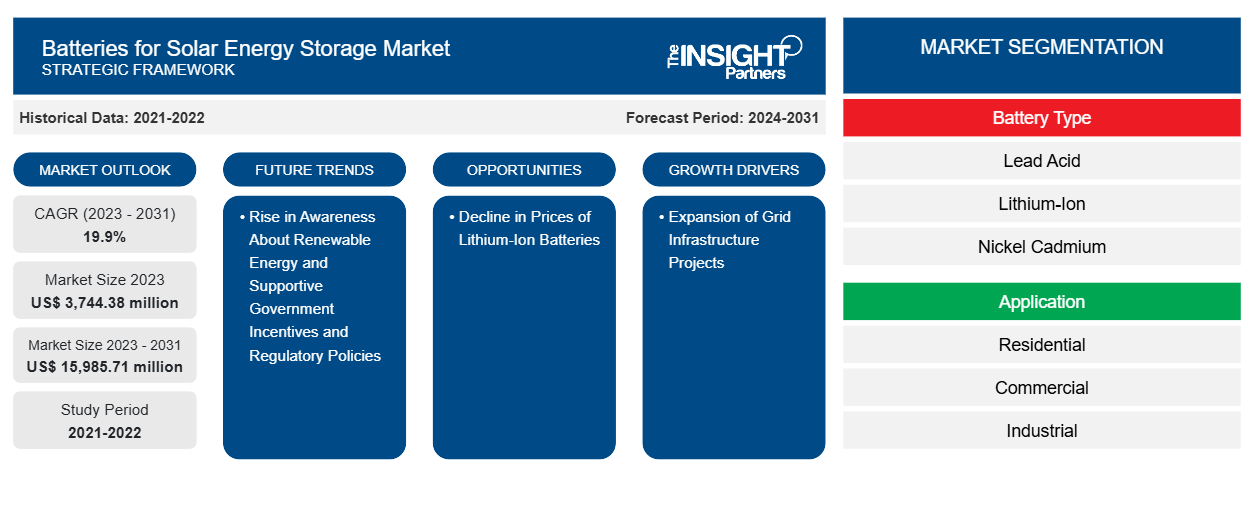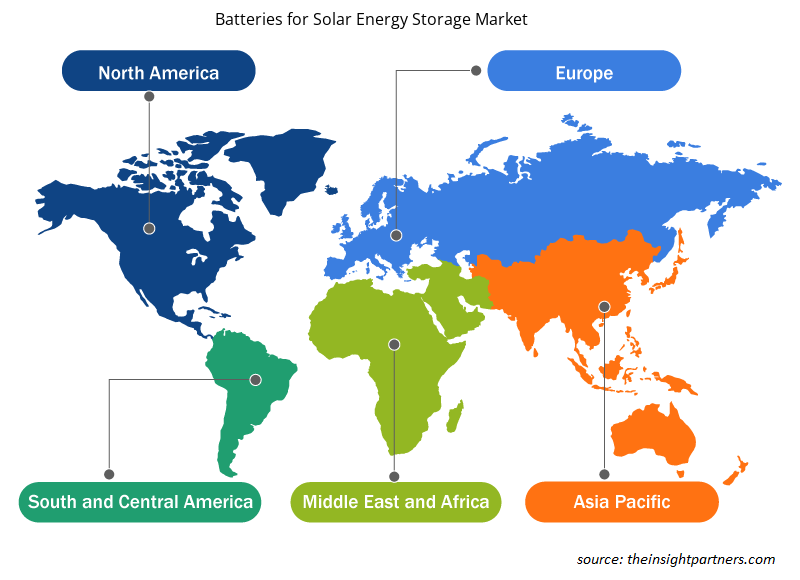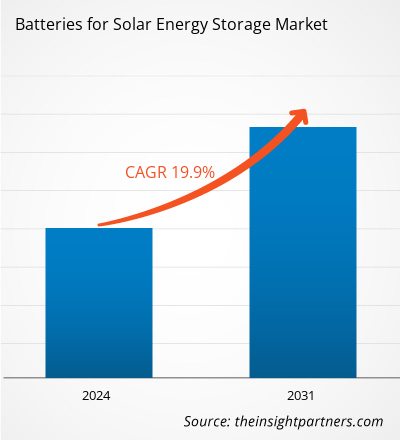The Batteries for Solar Energy Storage Market size is projected to reach US$ 15,985.71 million by 2031 from US$ 3,744.38 million in 2023. The market is expected to register a CAGR of 19.9% in 2023–2031. The growing environmental awareness to decrease carbon emissions through the integration of effective energy conservation is likely to remain a key batteries for solar energy storage market trends.
Batteries for Solar Energy Storage Market Analysis
The growing expansion of solar and renewable energy projects is the key factor stimulating the requirement for batteries for solar energy storage. Renewable energy sources portray a critical role in securing sustainable energy with lower emissions. The growing awareness for energy efficiency has been encouraged to increase the application of solar, biomass, wind, waste, and hydropower energies. Clean energy is less harmful and often cheaper. Solar energy storage systems are devices that preserve energy for later consumption after sundown or during energy demand peaks. Hence, developed and developing economies are strongly promoting and adopting solar energy as an alternative to conventional energy sources, which is driving the demand for batteries for solar energy storage.
Batteries for Solar Energy Storage Market Overview
The rise in demand for solar energy is driven by an increase in environmental pollution and the provision of government incentives & tax rebates to install solar panels. Supportive government policies and regulations for installing solar panels are driving the market. In countries such as China, the US, and India, FiT, investment tax credits, and capital subsidies are the prominent policies and regulations boosting the installation of solar plants, which is having an encouraging impact on the growth of the solar energy storage market globally.
Customize This Report To Suit Your Requirement
You will get customization on any report - free of charge - including parts of this report, or country-level analysis, Excel Data pack, as well as avail great offers and discounts for start-ups & universities
Batteries for Solar Energy Storage Market: Strategic Insights

- Get Top Key Market Trends of this report.This FREE sample will include data analysis, ranging from market trends to estimates and forecasts.
You will get customization on any report - free of charge - including parts of this report, or country-level analysis, Excel Data pack, as well as avail great offers and discounts for start-ups & universities
Batteries for Solar Energy Storage Market: Strategic Insights

- Get Top Key Market Trends of this report.This FREE sample will include data analysis, ranging from market trends to estimates and forecasts.
Batteries for Solar Energy Storage Market Drivers and Opportunities
Development of Grid Infrastructure Projects Driving Demand for Batteries for Solar Energy Storage
The growing financial aids in the grid-scale battery storage system is driving the market’s growth. For instance, in July 2022, Solar Energy Corp. and NTPC accomplished the tenders for standalone energy storage systems. This helped in accelerating the investment, supporting domestic manufacturing and accelerating the development of new business models. The development of grid infrastructure projects is fueling the demand for grid energy storage systems, further driving the batteries for the solar energy storage market. For example, in March 2022, Power Grid Corporation of India invested in five projects worth US$ 103.42 million across India. Likewise, in June 2022, the State Grid Corporation of China annouced to fund about US$ 74.5 billion in power grid projects. Thus, such investments and initiatives in grid expansion projects are propelling the demand for grid energy storage systems.
Decline in Prices of Lithium-Ion Batteries – An Opportunity in Batteries for Solar Energy Storage Market
The drop in the price of lithium-ion batteries is continuing a favorable growth opportunity for the market. As per the studies conducted by the Massachusetts Institute of Technology, further steep declines in cost could be possible, which could positively impact items such as cell phones, laptops, stationary storage, electric vehicles, and battery storage, which still need to become more reasonable for the mass uptake that is foreseen. The drop in the price of lithium-ion batteries is primarily attributed to public-funded research, primarily in chemistry and materials science, which has contributed the most to the cost reduction of the batteries. Thus, declining prices of lithium-ion batteries hold lucrative opportunities for battery manufacturers, augmenting production capabilities and helping the market grow faster.
Batteries for Solar Energy Storage Market Report Segmentation Analysis
Key segments that contributed to the derivation of the batteries for solar energy storage market analysis are battery type, application, and connectivity.
- Based on the battery type, the batteries for the solar energy storage market have been divided into lead-acid, lithium-ion, nickel cadmium, and others. The lithium-ion segment held a larger market share in 2023.
- In terms of application, the market has been segmented into residential, commercial, and industrial. The industrial segment dominated the market in 2023.
- In terms of connectivity, the market has been segmented into off-grid and on-grid. The on-grid segment dominated the market in 2023.
Batteries for Solar Energy Storage Market Share Analysis by Geography
The geographic scope of the batteries for solar energy storage market report is mainly divided into five regions: North America, Asia Pacific, Europe, Middle East & Africa, and South America/South & Central America.
The Asia Pacific is leading the batteries for the solar energy storage market in 2023. Countries such as China, India, and Japan are the leading countries holding a large portion of the market share, which is projected to increase in the coming years. The faster deployment of solar PV plants, growing awareness among consumers, increasing investment from leading players in the solar industry, and supportive policy frameworks and regulations from the government are the key factors attributed to the growth of batteries for the solar energy storage market in the Asia Pacific region. The countries in the Asia Pacific are moving towards increasing the production of solar energy. The regulatory bodies and favorable policy framework are helping escalate the production. To achieve the ambitious target, the Government of India introduced various schemes to encourage the generation of solar power in the country, such as the Solar Park Scheme, CPSU Scheme, Defense Scheme, VGF Schemes, Bundling Scheme, Canal bank & Canal top Scheme, and Grid Connected Solar Rooftop Scheme. China is one of the leading countries in the production of solar energy along with storage solutions globally.
Batteries for Solar Energy Storage Market Regional Insights
The regional trends and factors influencing the Batteries for Solar Energy Storage Market throughout the forecast period have been thoroughly explained by the analysts at Insight Partners. This section also discusses Batteries for Solar Energy Storage Market segments and geography across North America, Europe, Asia Pacific, Middle East and Africa, and South and Central America.

- Get the Regional Specific Data for Batteries for Solar Energy Storage Market
Batteries for Solar Energy Storage Market Report Scope
| Report Attribute | Details |
|---|---|
| Market size in 2023 | US$ 3,744.38 million |
| Market Size by 2031 | US$ 15,985.71 million |
| Global CAGR (2023 - 2031) | 19.9% |
| Historical Data | 2021-2022 |
| Forecast period | 2024-2031 |
| Segments Covered |
By Battery Type
|
| Regions and Countries Covered | North America
|
| Market leaders and key company profiles |
Batteries for Solar Energy Storage Market Players Density: Understanding Its Impact on Business Dynamics
The Batteries for Solar Energy Storage Market is growing rapidly, driven by increasing end-user demand due to factors such as evolving consumer preferences, technological advancements, and greater awareness of the product's benefits. As demand rises, businesses are expanding their offerings, innovating to meet consumer needs, and capitalizing on emerging trends, which further fuels market growth.
Market players density refers to the distribution of firms or companies operating within a particular market or industry. It indicates how many competitors (market players) are present in a given market space relative to its size or total market value.
Major Companies operating in the Batteries for Solar Energy Storage Market are:
- Alpha ESS Co., Ltd.
- BYD Motors Inc.
- HagerEnergy GmbH
- ENERSYS
- Kokam Battery Manufacturing Co.,LTD
- Leclanché SA
Disclaimer: The companies listed above are not ranked in any particular order.

- Get the Batteries for Solar Energy Storage Market top key players overview
Batteries for Solar Energy Storage Market News and Recent Developments
The Batteries for Solar Energy Storage Market is evaluated by gathering qualitative and quantitative data post primary and secondary research, which includes important corporate publications, association data, and databases. The following is a list of developments in the market for innovations, business expansion, and strategies:
- In January 2023, AlphaESS introduced a modular portable power station equipped with LiFePO4 Batteries at CES 2023. (Source: AlphaESS, Press Release/Company Website/Newsletter)
- In February 2024, EnerSys announced its plan to establish a 4-GWh lithium cell factory in South Carolina. (Source: EnerSys, Press Release/Company Website/Newsletter)
Batteries for Solar Energy Storage Market Report Coverage and Deliverables
The “Batteries for Solar Energy Storage Market Size and Forecast (2021–2031)” report provides a detailed analysis of the market covering the following areas:
- Batteries for Solar Energy Storage Market size and forecast at global, regional, and country levels for all the key market segments covered under the scope
- Market dynamics such as drivers, restraints, and key opportunities
- Batteries for Solar Energy Storage Market Trends
- Detailed PEST and SWOT analysis
- Batteries for Solar Energy Storage Market analysis covering key market trends, Global and regional framework, major players, regulations, and recent market developments
- Batteries for Solar Energy Storage Industry, landscape and competition analysis, covering market concentration, heat map analysis, prominent players, and recent developments
- Detailed company profiles
- Historical Analysis (2 Years), Base Year, Forecast (7 Years) with CAGR
- PEST and SWOT Analysis
- Market Size Value / Volume - Global, Regional, Country
- Industry and Competitive Landscape
- Excel Dataset
- Oil and Gas Fishing Market
- Wireline Services Market
- Oil Country Tubular Goods Market
- Europe, MENA, North America Portable Integrated Photovoltaic Market
- Forklift Battery Market
- Transcritical CO2 Market
- Gas Engine Market
- District Heating Market
- Managed Pressure Drilling Market
- Geothermal Power Generation Market
Testimonials
I wish to appreciate your support and the professionalism you displayed in the course of attending to my request for information regarding to infectious disease IVD market in Nigeria. I appreciate your patience, your guidance, and the fact that you were willing to offer a discount, which eventually made it possible for us to close a deal. I look forward to engaging The Insight Partners in the future, all thanks to the impression you have created in me as a result of this first encounter.
DR CHIJIOKE ONYIA, MANAGING DIRECTOR, PineCrest Healthcare Ltd.The Insight Partners delivered insightful, well-structured market research with strong domain expertise. Their team was professional and responsive throughout. The user-friendly website made accessing industry reports seamless. We highly recommend them for reliable, high-quality research services
Yukihiko Adachi CEO, Deep Blue, LLC.Reason to Buy
- Informed Decision-Making
- Understanding Market Dynamics
- Competitive Analysis
- Customer Insights
- Market Forecasts
- Risk Mitigation
- Strategic Planning
- Investment Justification
- Identifying Emerging Markets
- Enhancing Marketing Strategies
- Boosting Operational Efficiency
- Tracking Industry Innovations
- Aligning with Regulatory Trends
Yes! We provide a free sample of the report, which includes Report Scope (Table of Contents), report structure, and selected insights to help you assess the value of the full report. Please click on the "Download Sample" button or contact us to receive your copy.
Absolutely — analyst assistance is part of the package. You can connect with our analyst post-purchase to clarify report insights, methodology or discuss how the findings apply to your business needs.
Once your order is successfully placed, you will receive a confirmation email along with your invoice.
• For published reports: You’ll receive access to the report within 4–6 working hours via a secured email sent to your email.
• For upcoming reports: Your order will be recorded as a pre-booking. Our team will share the estimated release date and keep you informed of any updates. As soon as the report is published, it will be delivered to your registered email.
We offer customization options to align the report with your specific objectives. Whether you need deeper insights into a particular region, industry segment, competitor analysis, or data cut, our research team can tailor the report accordingly. Please share your requirements with us, and we’ll be happy to provide a customized proposal or scope.
The report is available in either PDF format or as an Excel dataset, depending on the license you choose.
The PDF version provides the full analysis and visuals in a ready-to-read format. The Excel dataset includes all underlying data tables for easy manipulation and further analysis.
Please review the license options at checkout or contact us to confirm which formats are included with your purchase.
Our payment process is fully secure and PCI-DSS compliant.
We use trusted and encrypted payment gateways to ensure that all transactions are protected with industry-standard SSL encryption. Your payment details are never stored on our servers and are handled securely by certified third-party processors.
You can make your purchase with confidence, knowing your personal and financial information is safe with us.
Yes, we do offer special pricing for bulk purchases.
If you're interested in purchasing multiple reports, we’re happy to provide a customized bundle offer or volume-based discount tailored to your needs. Please contact our sales team with the list of reports you’re considering, and we’ll share a personalized quote.
Yes, absolutely.
Our team is available to help you make an informed decision. Whether you have questions about the report’s scope, methodology, customization options, or which license suits you best, we’re here to assist. Please reach out to us at sales@theinsightpartners.com, and one of our representatives will get in touch promptly.
Yes, a billing invoice will be automatically generated and sent to your registered email upon successful completion of your purchase.
If you need the invoice in a specific format or require additional details (such as company name, GST, or VAT information), feel free to contact us, and we’ll be happy to assist.
Yes, certainly.
If you encounter any difficulties accessing or receiving your report, our support team is ready to assist you. Simply reach out to us via email or live chat with your order information, and we’ll ensure the issue is resolved quickly so you can access your report without interruption.





















 Get Free Sample For
Get Free Sample For